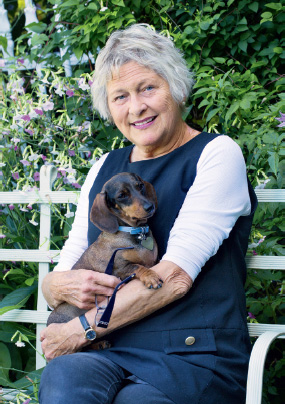
HELEN DILLON
Helen Dillon’s surprising town garden

The Irish counties of Cork, Waterford and Wicklow, and the Dublin area in particular, have seen the emergence of several outstanding new gardens. Leading the way is Helen Dillon’s influential garden in Sandford Terrace, central Dublin. What sets her garden apart is its fresh approach, dynamic feel and the wealth of ideas that keep it from standing still. The 0.3- hectare/¾-acre plot has been continually evolving since it was first laid out in 1973, and is still capable of surprising and delighting visitors. Helen Dillon has been tending plants for more than seventy years, ever since she was given her first primulas as a child growing up in Scotland. She has made a name for herself on both sides of the Atlantic, gives talks, works untiringly in her garden, is always receptive to new ideas and is not afraid of change. Awarded the Veitch Memorial Medal by the Royal Horticultural Society in 1999, an honour which placed her within the inner circle of England’s gardening world, Helen Dillon could easily have left it at that. Her garden was considered to be the epitome of a romantic plant-filled haven. Surrounding an immaculate central lawn were mixed borders where rare plants collected on overseas expeditions grew cheek by jowl with traditional herbaceous perennials. Beyond the lawn, a semicircle of arches covered in ivy and clematis framed a circular pool with an antique ‘wedding cake’ fountain in the middle, creating an eye-catching feature at the end of a central vista. Hidden behind the arches was another flower-filled garden room, adorned with a charming sculpture of the goddess Diana. The north-facing front garden was equally well designed, with a curved path leading to the front door between gently sloping beds brimming with plants. Having opened to the public in the early 1990s, the garden was admired, applauded and declared a paradise.
EVER-CHANGING TAPESTRY
However, a garden is no museum: it evolves and is never completely finished. Plants get moved around. New ideas are brought in. And number 45 Sandford Road is no exception. In 1985, inspired by a visit to Morocco, Helen Dillon made the first in a series of changes that astonished friends and visitors – she removed the fountain, thereby converting the pool into a circle of still water. About ten years later it was the front garden’s turn. Helen Dillon felt the house deserved a better setting to enhance its classical Georgian facade. ‘A house needs to sit down,’ is how she puts it. Acting on the advice of a friend, landscape architect Feargus McGarvey, she had a retaining wall built parallel to the driveway, steps added and a large area by the front door paved in sandstone. The house now had a dignified entrance. And whereas cars had previously been in full view of the kitchen window, they were now hidden by the wall. No sooner had fans of the garden got used to these changes than the next round was underway. Helen Dillon had been writing a column for the Irish Sunday Tribune since 1992, in which she discussed the garden’s ups and downs. Readers knew and grew attached to the garden, even identifying so closely with it that they perceived it to be in some way theirs. Many, including certain garden aficionados, were horrified when it was redesigned in 2000. The central lawn was completely removed and replaced by a long rectangular pool, flanked on either side by a wide band of silver-grey Irish granite paving. The existing circular pool, surrounded by stone setts, was integrated into the design and the borders substantially widened. Towards the house, the broad garden steps bridging the level changes between the lower ground floor and the garden were reconfigured and divided into two narrower flights of steps with a cascade in between. The only remnants of the old garden were two sphinxes on either side of the steps, which still stand guard over the dynamic new design. These radical changes were partly due to Rosemary Verey (see here), who had visited Helen’s garden while on a lecture tour of Ireland in the 1980s and commented that the lawn might benefit from a central rill. Subsequent trips to India and Spain, in particular to the Alhambra’s famous Myrtle Courtyard, helped reinforce this idea in Helen’s mind. A major drawback of the central lawn had been how it seemed to swallow light, making the surroundings duller and robbing the planting of some of its brilliance. By contrast, sheets of water are light-enhancing, illuminating overcast days.
Helen’s husband Val compares her garden to a stage with a large cast of extras in the form of ‘movable’ plants in containers. Waiting in the wings are lilies, dahlias, Alstroemeria and many others planted in ordinary black plastic pots and metal dustbins, which are unobtrusive and do not compete visually with the plants. ‘What I love is the impermanence of container gardening,’ says Helen. ‘Bought yet another plant? Can’t think where to put it? Simple: buy another pot. With containers a whole new universe is revealed … If you don’t like last year’s creation never do it again.’ The theatrical effect is particularly evident from the drawing room on the raised ground floor. Seen from this perspective, the garden appears to be far longer than its 54m/177ft, due not only to the central canal but also to the open nature of the site. Aside from an old apple tree, all the trees placed judiciously around the garden are smaller-growing, including a beautiful paperbark maple (Acer griseum) and pinnate-leaved Aralia.

Lawns have been banished from this garden.
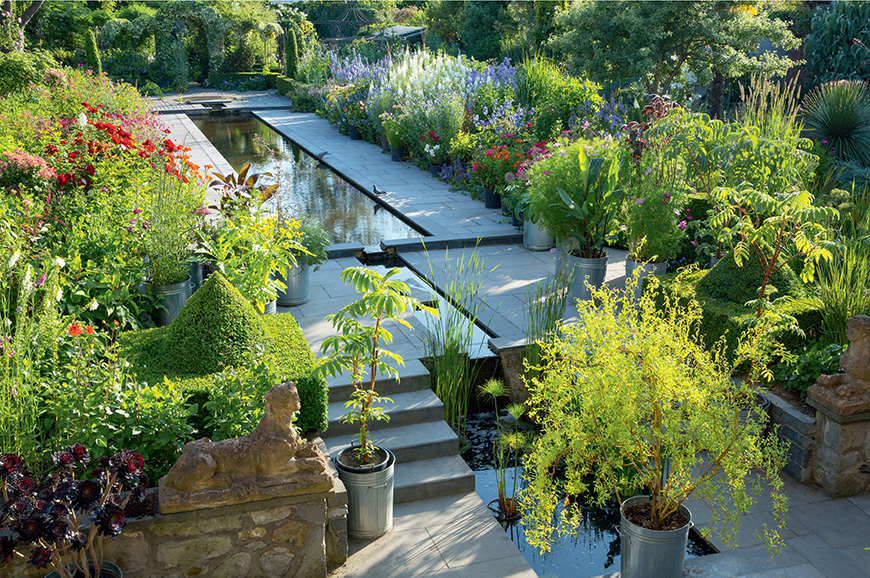
A canal forms the tranquil central feature and appears to hold the overflowing beds in check.
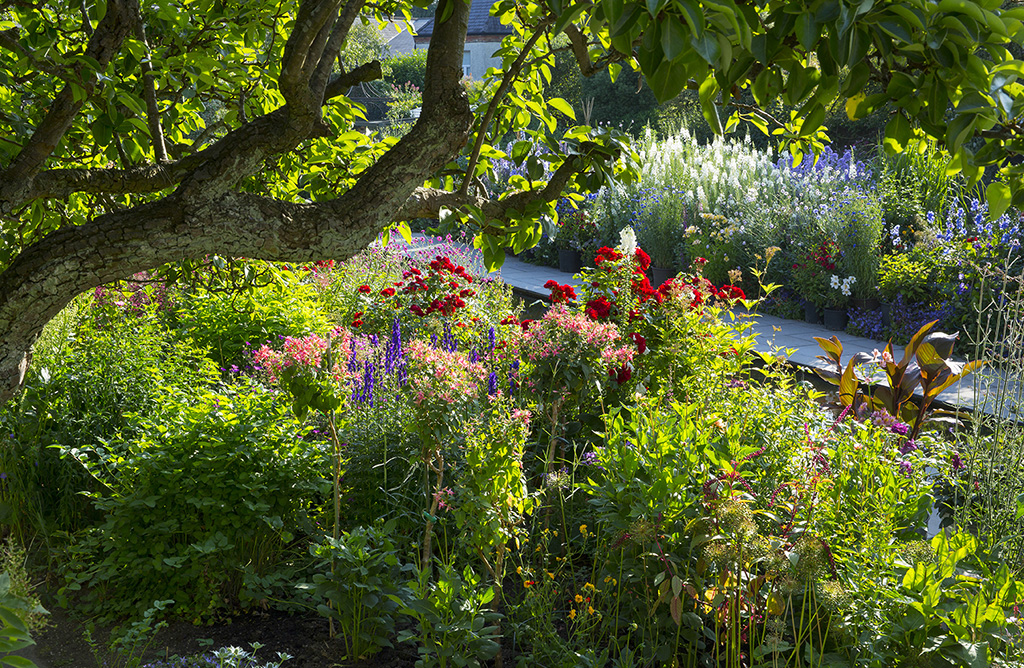
Should any gaps appear among the host of flowers in the borders alongside the canal, in come containers filled with a diversity of plants, from cosmos to willows.
Colour is one of the most striking aspects of the garden. As Helen Dillon explains, before the changes of 2000 took place the garden’s colour scheme was based on a palette of pastels ‘that everyone has had for a hundred years’. Following a visit to Metz in France, where Helen admired the pretty, silvery municipal flower displays, she decided to switch to a colour scheme resembling an ‘over-painted picture with a bit of blue thrown in’. The finished effect was to look like a packet of Smarties, zinging with primary and secondary candy colours. So, the border on the left of the canal is now reserved mainly for reds and oranges, while the one on the right is predominantly blue and white. As befits her motto ‘don’t be afraid of orange’, Helen has a succession of different plants on display in this glowing colour. Alstroemeria fell out of fashion long ago but has been restored to acceptability by Helen’s use of it as a filler in the hot bed. Opposite, cool shades are provided by bellflowers (Campanula), white valerian (Centranthus ruber ‘Albus’) and noble delphiniums, which are cut back after flowering to bloom again from early July into August. Helen is always ready to try a new species even if it ends in tears, as was the case with agave-like Furcraea parmentieri. For despite the mild winters and a protective covering, this precious plant did not survive, proving that even an experienced gardener can still learn a thing or two.
Trial and error is a hallmark of this garden, as is a willingness to adapt and incorporate new ideas. In 2005 the front garden underwent another makeover, the sandstone paving replaced by larger slabs of light grey Chinese granite and the planting completely altered. Inspired by a three-day train journey between Moscow and Berlin during which Helen travelled through birch woods, she decided to plant a stand of filigree Betula ‘Fascination’ underplanted with angel’s fishing rods (Dierama) and ornamental grasses such as Stipa tenuissima.
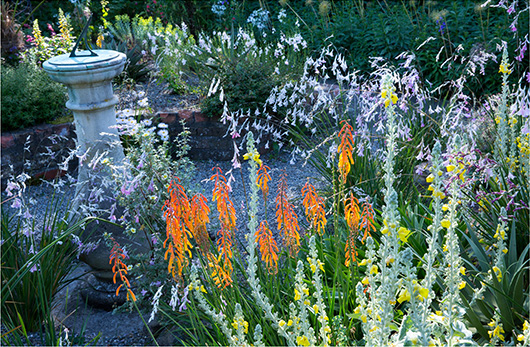
Helen Dillon is a passionate plant collector. Pictured here is rare Kniphofia thomsonii var. thomsonii and yellow Verbascum ‘Frosted Gold’, with the distinctive wands of a white-flowered Dierama behind.

Miss Willmott’s ghost (Eryngium giganteum) and striking marsh orchids (Dactylorhiza × braunii) grow in the dappled shade of an apple tree and Rhus typhina.
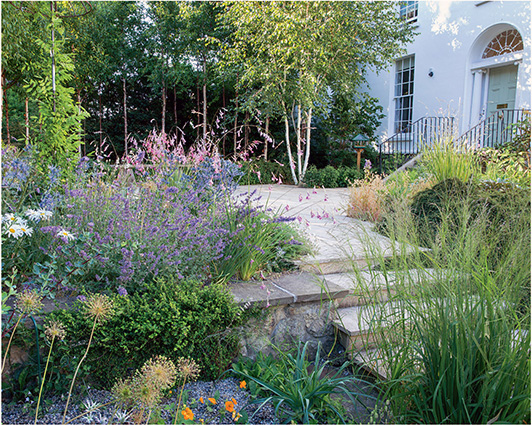
Inspired by a scene encountered when travelling by train from Moscow to Berlin, Helen Dillon decided to plant birch trees in her front garden: an unusual prelude to a truly inspiring garden.
Although Helen Dillon yearns for ‘virgin’ soil, hers is a long-established garden with soil that has been worked for over a century. She does her best to replenish it by bringing in tons of cow manure; not particularly elegant, perhaps, but essential if the plants are to flourish. That this is a private garden and not simply for show is also evident from the small vegetable patches casually tucked in behind the delphiniums. As someone open to experiment, Helen remains willing to concede defeat but often opts for a change of tack. After the local fox had finished off the last of the hens, she gave up on that idea. Nowadays, the end of the garden is enlivened by the trilling song from an aviary of bright yellow canaries – the perfect touch in an eclectic garden.
Helen Dillon’s garden does not conform to any particular trend and cannot be described as low-maintenance. Her short articles published monthly in The Garden magazine give a flavour of her informative, knowledgeable and witty style. Just like Vita Sackville-West, Helen Dillon writes from experience and from the heart, relating her knowledge and passion for plants. She is always receptive to fresh ideas. As she says of herself, ‘I want to be a creator, not a curator.’
GUIDING PRINCIPLES
|
It is essential to understand the garden’s basic conditions and be guided by them. |
|
Feed the soil, preferably with plenty of cow manure. |
|
Do not be squeamish if a plant is struggling: pull it out, send it to the compost heap and start afresh. |
|
Cultivate container plants in the greenhouse, then site outdoors to fill gaps. |
|
Ordinary metal dustbins or black plant pots are as good as expensive, eye-catching containers. |
|
Fish, blood and bone attracts foxes, which do a lot of damage digging up the soil. It is better to use rose fertilizer or even seaweed as an all-purpose plant food. A mycorrhizal (fungal) fertilizer is recommended, particularly for freshly planted roses or anything else that is struggling. |
|
How do you get rid of weeds? ‘I pick them up between finger and thumb and put them in a bucket,’ says Helen. |
|
Ensure plants are properly staked. At 45 Sandford Road, this task falls within Val Dillon’s remit. He prefers semicircular metal rings with two prongs, as used by Margery Fish, and has them specially made by the blacksmith in sizes of 40cm/16in, 60cm/2ft and 90cm/3ft. |
SIGNATURE PLANTS
|
Sea hollies. Eryngium × oliverianum can live up to thirty years in the same soil and still be going strong. Eryngium × zabelii combines well with Diascia personata. |
|
Colour accents, such as Papaver somniferum flowering among Clematis × aromatica. |
|
Californian tree poppy (Romneya coulteri). |
|
Angel’s fishing rods in variety, including Dierama ‘Blue Belle’ (unfortunately not frost-hardy and needing to be overwintered indoors). |
|
Alstroemeria, once popular as a floral decoration for the dining table, deserves a more prominent place in the garden. Opt for taller varieties and grow them in pots, as these plants have a tendency to spread quickly. |
